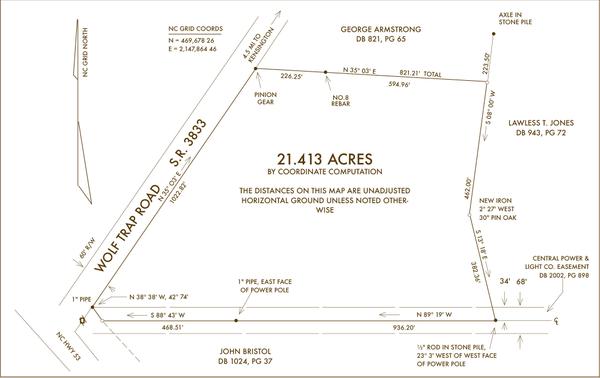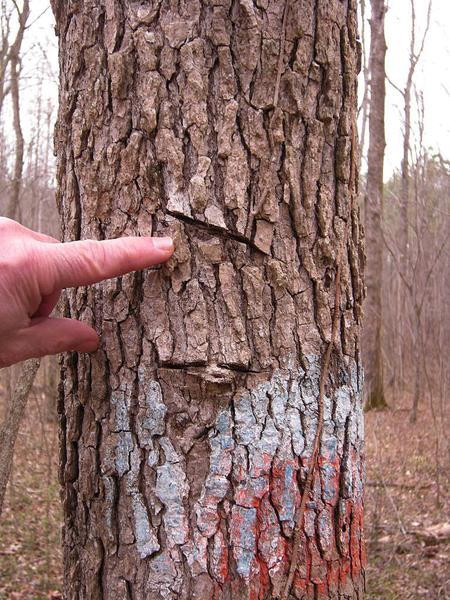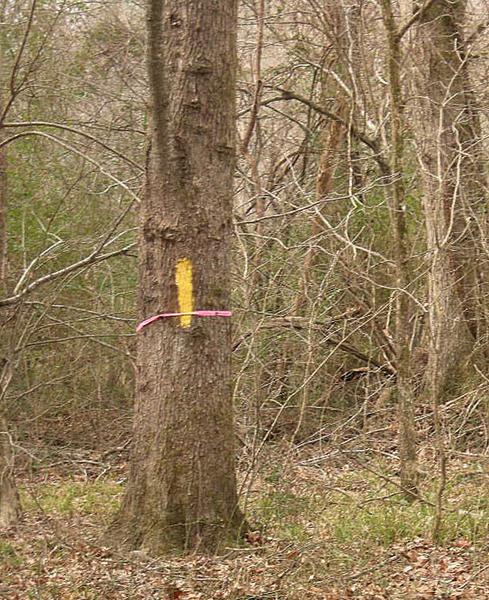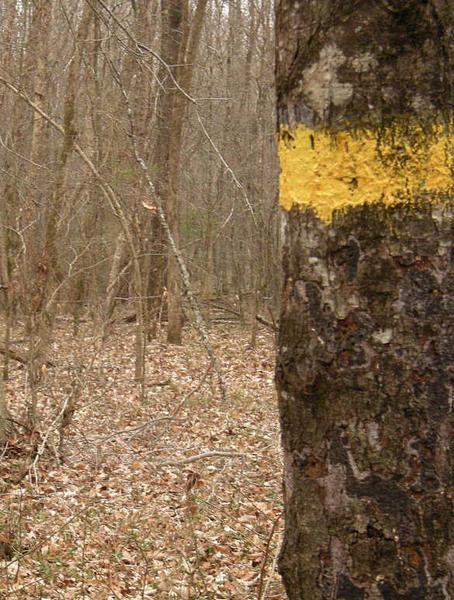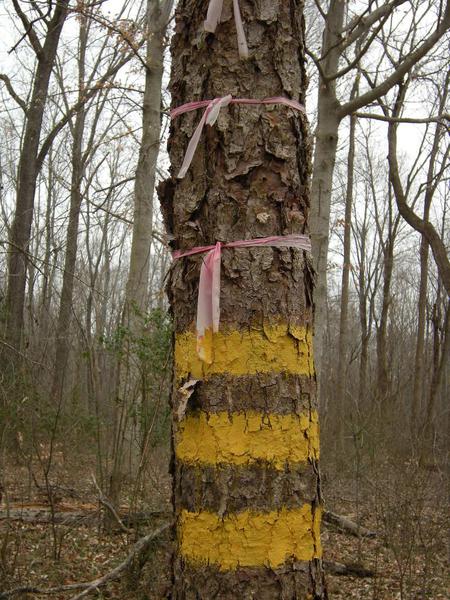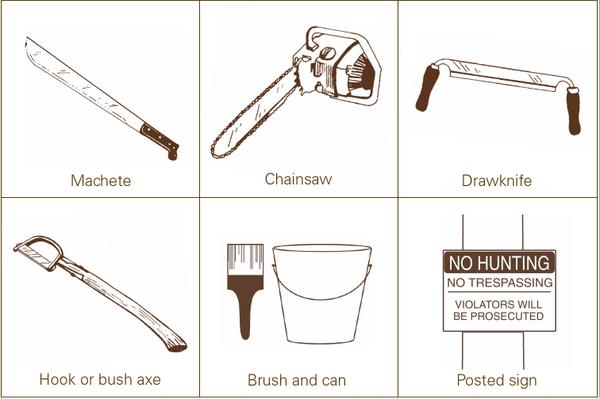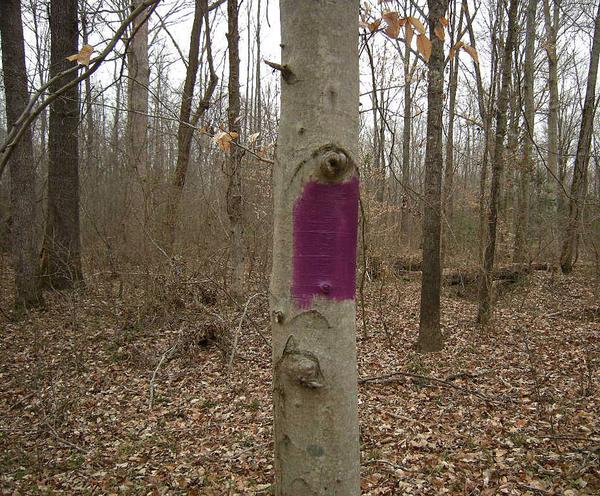With the high value of timbered forest property today, landowners would be well advised to take sufficient steps to protect their investment. Maintaining property lines and boundaries is one of the simplest yet most often overlooked forms of protection from theft, trespass, and encroachment. This publication details how to maintain or reestablish property lines and includes details on the NC Landowner Protection Act provisions
Why Identify Forest Property Boundaries?
"Finding the corners’’ is typically the only way many landowners can identify their property boundaries. While simply locating and marking corners might suffice on residential properties, doing so is inadequate for forest property where corners can be thousands of feet apart. As a forest landowner, establishing and maintaining well-marked lines can save you money, liability, and litigation. The following events require or are aided by well-marked and posted property lines.
Timber Sales
Selling timber entails a precise location of the sale's boundaries to conduct a legal and legitimate business transaction. Often the cost involved in resurveying boundaries can be the highest cost of conducting a timber sale. However, survey costs for reestablishing boundary lines can be deducted as a cost of sale. A survey conducted in a nontimber sale year should be capitalized (added to the land’s basis).
Subdivision or Property Transfer
Each time a property is sold, transferred, or subdivided, a survey must be conducted by a registered land surveyor to verify the location, extent, and boundaries of the property.
Covenants and Restrictions
Many land parcels carry restrictions on the placement of buildings, setbacks for fences, or other limits on development. Locating the exact property lines can help an owner comply with these restrictions.
Management Activities
Timber harvesting, site preparation, and prescribed burning operations must be conducted within the confines of one’s property. Clearly defined property lines will help avoid conflicts and potential encroachment on adjoining lands.
Trespass
Unwanted trespass and poaching can be minimized by marking and posting property lines. In the case of hunting, trespass prosecution can take place only for lands that have “posted” notices placed on them. North Carolina law states that land must be posted at intervals of no more than 200 feet. The NC Landowner Protection Act of 2011 allows wildlife officers to enforce trespass laws where purple-colored painted boundaries are used in lieu of signage. (Details follow at the end of this publication.)
Adverse Possession
Unmarked property boundaries can lead to a loss of land. Land boundaries that are uncontested for a period of as little as seven years can lead to loss of land by the original owner.
Timber Theft
Unmarked property can be susceptible to timber theft (timber trespass). The best protection against timber theft is a well-marked, maintained boundary line that is frequently checked for encroachment.
Liability
Property ownership comes with many responsibilities and obligations to invited and uninvited users. Well-marked or posted boundaries can help minimize land owner liability, especially in the cases of recreation and trail use where no fees are exchanged.
Easements and Rights-of-Way
Often some rights of land ownership are forfeited to another party. An easement or right-of-way, which allows the holder a privilege to enter or make specific use of someone's land, is most common. Clearly locating the easement and respecting these “interior” boundaries can minimize problems with the easement holder (often a utility company).
Where to Begin?
The most efficient way to maintain property lines is to start after a recent survey has been completed, typically at the time of acquisition. Because many forest properties have remained in one family for decades, doing so may not always be practical. The next best option is to begin maintaining a line along a recently surveyed or harvested adjoining property, since adjacent ownerships share at least one common boundary. Subsequent lines can be marked following a survey from a timber sale or transfer. The survey cost can be deducted as a sale expense in the year of a timber sale and only for that portion of the survey that defines a timber sale area. For more information on the tax implications of surveying as a timber sale expense, see IRS Publication 225, Farmer’s Tax Guide.
Establishing Lines from a Deed Description
In the absence of a recent survey, the location of property corners, the distances, and bearings can be obtained from a deed description available at the office of the county's Register of Deeds (Figure 1). Deed descriptions of the property should allow for an approximate location of most corners. Then, with the use of a compass, a helper, and a fiberglass tape, property locations can be established. One cautionary note for do-it-yourselfers: while any landowner or forestry consultant may reestablish a property line, they should do so with the understanding that they become responsible, and thus liable, for damages due to any erroneous location. If there is any doubt about the property line, a professional survey is the only choice. (Note that state law prohibits the obliteration or movement of any property corner, even when the landowner believes it is incorrectly placed.)
Marking Property Lines
Land surveyors routinely “brush” or clear property lines during a boundary survey. Typically, a swath is cleared with a machete or chainsaw to allow for clear sight lines between survey points or stations. During the “brushing” of property lines, trees directly on the interior are often given one to three slash marks on the bark with a chainsaw (Figure 2). These marks are easy to locate once one knows what to look for. The combination of brushing and slash marks allows landowners to follow up the surveyor and paint or post the property line.
Preparing Trees for Paint
A drawknife or machete is used to scrape a smooth 5-inch to 6-inch band in the outer bark at roughly eye level. Working in two-person crews, the scraper can quickly prepare each tree for the painter following directly behind.
Painting Forest Property Lines
One widely used method for painting property lines uses a series of painted bands or blazes to mark line position and corners. This method includes these components:
- A vertical line for centerline trees (located on the property line) (Figure 3).
- One band for interior trees adjacent to the property line (facing the line) (Figure 4).
- Two bands for a change in the line (toward direction of change) (Figure 5).
- Three bands to mark the property corner (facing the corner) (Figure 6). Sometimes a tree located directly on a corner will also be marked with a large X.
Painting half of each line or corner tree allows for easy visibility and directional location of property lines. Always use an exterior oil-based paint for maximum durability. Specially prepared boundary paint, which has a field-tested durability of 10 years or more, is available in high visibility colors (white, yellow, orange, red, and blue).
Well-marked property lines can last for many years, but they should be checked for integrity annually and more frequently when severe storms, hurricanes, or wildfire have occurred in the vicinity. Other events that prompt frequent property line inspection include nearby harvesting and during insect and disease outbreaks. A well-marked and patrolled property line is your best defense against intrusion and trespass. Frequently used tools for boundary maintenance are highlighted in Figure 7.
Benefit from the NC Landowner Protection Act
The NC Landowner Protection Act (passed in 2011) strengthens existing trespass law on private property by clarifying general trespass laws and enforcement. The Act provides a simplified way for landholders to post their property with purple paint. The landholder can paint a vertical line of purple paint on trees or posts around a property boundary or areas intended to prohibit trespass (Figure 8).
The NC Landowner Protection Act also defines the requirements pertaining to written permission to hunt, fish, or trap on posted lands:
- The written permission must be dated within the last 12 months.
- The permission must be signed by the landowner, lessee, or agent of that land.
- The written consent must be carried on the visitor's person while on-site and provided upon request of any law enforcement officer.
The NC Landowner Protection Act allows wildlife officers to enforce trespass laws on-site. And it allows landowners to post land using purple paint marks and/or by posting no-trespassing signs as allowed before 2011.
For more specific information about the NC Landowner Protection Act, including how to post purple paint marks on private lands, to obtain a Landowner Protection Act FAQ, and view samples of permission letters, visit the North Carolina Wildlife Resources Commission.
Read more at NC State Extension Forestry.
Summary
The establishment and maintenance of property lines is a worthwhile investment that can yield many valuable dividends to property owners. Maintain lines directly after a survey for the greatest benefit and least cost. A working knowledge of North Carolina statutes related to trespass and liability can also greatly enhance your property protection efforts. Consult with a professional forestry consultant, licensed surveyor, and attorney when dealing with property line matters as they affect your forestland.
Publication date: April 8, 2019
Reviewed/Revised: Jan. 20, 2024
WON-35
N.C. Cooperative Extension prohibits discrimination and harassment regardless of age, color, disability, family and marital status, gender identity, national origin, political beliefs, race, religion, sex (including pregnancy), sexual orientation and veteran status.

